Whereas national norms provide useful information which could be used as a benchmark to compare local districts and states to the larger population, it may be argued that norms which are developed on subjects that are more similar to those in one's classroom are more meaningful. Thus, a need for local and/or state norms also exists. This need is especially important for local district per-sonnel or state officials when monitoring changes in the fitness status of children under their purview.
Accordingly, the Iowa Youth Fitness Project was designed with two primary purposes in mind:(1) to gather baseline data on the physical fitness status of a sample of students representative of Iowa school children and (2) to promote a heightened awareness of the importance of physical fitness and physical parents, and children throughout Iowa. This study was undertaken through the sponsorship of the Iowa Governor's Council on Physical Fitness and Sports with finan-cial support provided by the Iowa Association for Health, Physical Education, Recreation and Dance (IAHPERD) and the University of Northern Iowa. A basic description of the project, an explanation of the test items used, and a summary of the findings were reported in the Spring 1992 issue of the IAHPERD) Jour-nal (Hensley, 1992). The intent of this paper is to pro-vide statewide norms on the following test items according to age and sex: (l) 1-mile walk/run, (2) sit--and-reach test, (3) sit up test, (4) pull up test, and (5) sum of triceps and calf skinfolds.
As the definition of physical fitness has evolved from one that almost exclusively focused on athletic performance to the modern health-related definition of physical fitness (Pate, 1991), so too has the basis for interpretation. It has been argued that health-related physical fitness should be assessed through the use of criterion-referenced standards rather than through population-based norms. The intention is to define specific cut-off scores on the various fitness tests which are said to represent desirable health standards needed to afford some degree of protection against hypo-kinetic disease.
Unfortunately, empirically validated standards for all test items have not been established and there is little agreement as to what constitutes acceptable standards. Whereas the movement towards the use of criterion--referenced standards is a noble one deserving the acclaim it is given, until such time that acceptable stan-dards can be derived, population-based norms will continue to play a significant role in the interpretation of physical fitness status. Moreover, Ross and colleagues (1987) cite several useful purposes for population-based fitness norms: (1) norms constitute a description of the current status of the population; (2) when tests occurs periodically, norms provide a basis for tracking change in the population over time; (3) norms can be used as a basis for comparison of selected subgroups with the population at large; and (4) relative status of an individual can be assessed by comparing his or her status with that of the population.
THE NEW NORMS
The norms (Tables 1 to 10 are found at the end of this paper) presented in this article are based on the testing of approximately 10,000 boys and girls, age 6 through 19, who were randomly selected from all Iowa public and parochial schools during the 1991 spring semester. A detailed description of the sampling procedure is provided elsewhere (Hensley, l992). The norms presented herein are based on a representative sample of Iowa school children and constitute the largest data set of physical fitness test scores reported heretofore for Iowa youth.
GUIDEILINES FOR USE
Percentile-rank norms are easily interpretable for both teachers and parents, indicating how a student's performance ranks relative to his or her peers. For in-stance, if a student scores at the 60th percentile on a given test, this means that the student performed better than 60% of the students who were used to develop the norms. Furthermore, if the sample of students used for developing the norms were selected in a ran-dom manner, one can be reasonably confident that the norms are representative of the defined population.
Thus, in the present case, since the students used for the development of the fitness norms were selected through random processes, the performance of a stu-dent scoring at the 60th percentile may be interpreted as being better than 60% of Iowa children of the same age and sex. Quite simply, the use of percentile norms in this manner can aid teachers, parents, and school officials in understanding how their students compare with other children throughout Iowa. Each of the tables highlights the 50th percentile, or median score to facilitate interpretation.
Although the identification of desired test scores based upon percentile norms is arbitrary in nature and somewhat precarious, the investigators for the NCYFS recommend the system previously adopted by AAHPERD (Ross et al, 1985). Scores below the 25th percentile are thought to be poor and are generally unacceptable. Scores at or above the 25th percentile, but below the 50 percentile are considered fair and are indicative of minimal fitness. Scores at or above the 50th percentile, but below the 75th percentile are acceptable (good), while scores at or above the 75th percentile are optimal (excellent). It is important to recognize that this classification scheme is completely arbitrary and users are advised to exercise caution in using it for interpretation purposes. Furthermore, the use of fitness test scores or the accompanying percentile-rank norms for grading purposes is not advised. The new norms can be used not only to assess current fitness levels, but also for exercise prescription, to monitor changes in fitness over time, and to evaluate one's physical education program.
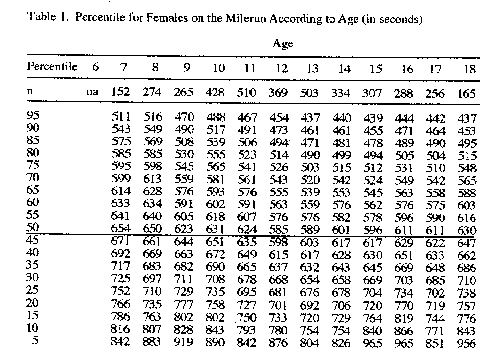
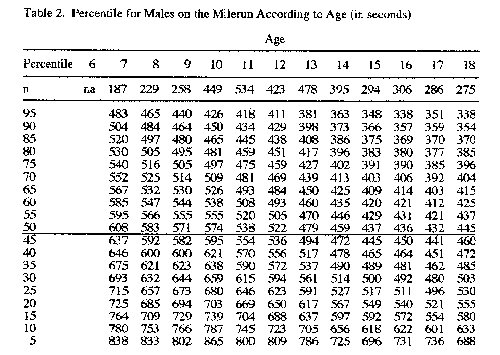
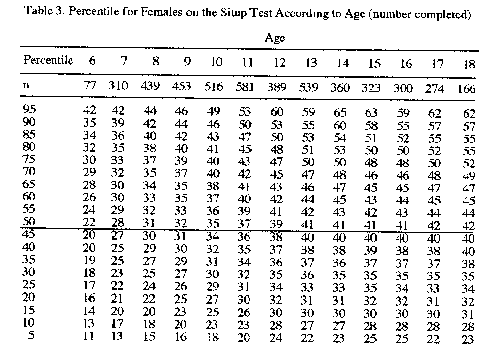
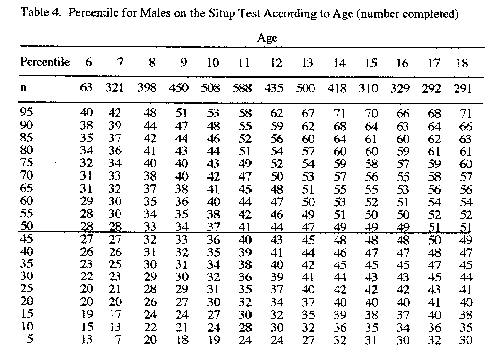

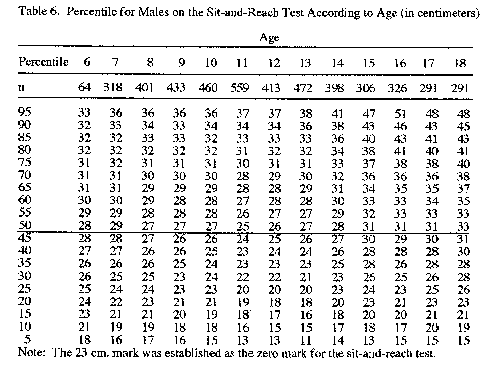
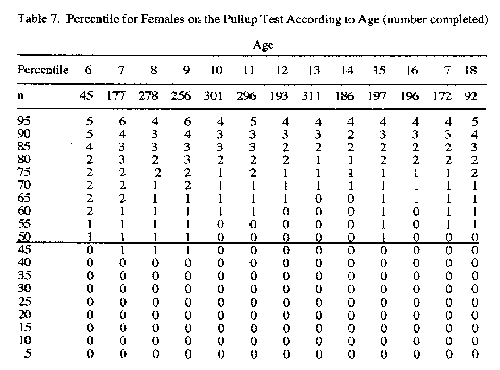
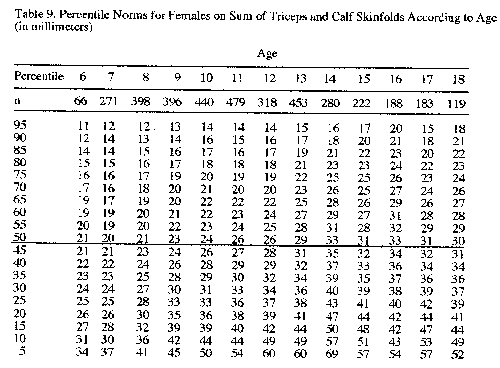
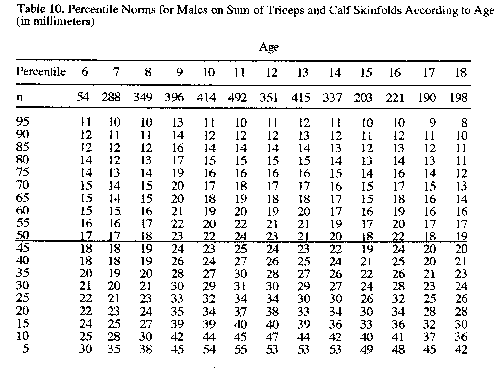
REFERENCES
Hensley, L. D. (1992). Evaluating the fitness of Iowa children: Findings of the Iowa youth fitness project. IAHPERD Journal, 25(2), 5-16.
Hensley, L. D., Aten, R., Baumgartner, T. A., East, W. B., Lambert, L. A., & Stillwell, J. L. (1989). A survey of grading practices in public school physical education. Journal of Research and Development in Education, 23(1), 37-42.
Pate, R. R. (1991). Health-related measures of children's physical fitness. Journal of School Health, 61(5), 23 1 -233.
Ross, J. G., Dotson, C.O., Gilbert, G. G., & Katz, S.J. ( 1985). New standards for fitness measurement. Journal of Physical Education, Recreation, and Dance, (1), 62-66.
Ross, J. Ci., Pate, R. R., Delpy, L. A., Gold, R. S., & Svilar, M. (l987). New health-related fitness norms. Journal of Physical Education, Recreation, and Dance, 58(12), 66-70.
Sallis, J. F. & McKenzie, T. L. (1991). Physical edu-cation's role in public health. Research Quarterly for Exercise and Sport, 62, 124 137. Simons-Morton, B. G., O'Hara, N. H., Simons-Morton, D. G., & Parcel, G. S. (1987). Children and fitness: A public health perspective. Research Quar-terly for Exercise and Sport, 58, 29~302.
U.S. Public Health Service (1990). Healthy people 2000: National health promotion and disease preven-tion objectives. Washington, D. C.: Government Printing Office.